
 Mars: Prospective Energy and
Material Resources
Mars: Prospective Energy and
Material Resources
Foreword by J. Marvin Herndon
  Mars: Prospective Energy and
Material Resources
Mars: Prospective Energy and
Material Resources
Foreword by J. Marvin Herndon |
 Mars,
the Red Planet, fourth planet from the Sun, forever linked with 19th and 20th
Century fantasy of a bellicose, intelligent Martian civilization. The romance
and excitement of that fiction remains today, even as technologically
sophisticated robotic orbiters, landers, and rovers seek to unveil Mars'
secrets; but so far, they have yet to find evidence of life. The aura of
excitement, though, is justified for another reason: Mars is a very special
place. It is the only planetary surface in the Solar System where humans, once
free from the bounds of Earth, might hope to establish habitable,
self-sufficient colonies.
Mars,
the Red Planet, fourth planet from the Sun, forever linked with 19th and 20th
Century fantasy of a bellicose, intelligent Martian civilization. The romance
and excitement of that fiction remains today, even as technologically
sophisticated robotic orbiters, landers, and rovers seek to unveil Mars'
secrets; but so far, they have yet to find evidence of life. The aura of
excitement, though, is justified for another reason: Mars is a very special
place. It is the only planetary surface in the Solar System where humans, once
free from the bounds of Earth, might hope to establish habitable,
self-sufficient colonies.
Endowed with an insatiable drive, focused motivation, and a keen sense of
exploration and adventure, humans will undergo the extremes of physical hardship
and danger to push the envelope, to do what has not yet been done. Because of
their very nature, there is little doubt that humans will in fact conquer Mars.
But even earth-bound extremes, such those experienced by the early polar
explorers, may seem like a walk in the park compared to future experiences on
Mars.
Mars is a small planet, with a radius about half that of Earth, but it is a place of extremes. The temperature can fall to a low of -140 degC (-220 degF) in polar winter, but seem an almost pleasant 20 degC (68 degF) in tropic summer. The atmosphere is thin. Even at the surface, Mars' atmospheric pressure is comparable to Earth's at an altitude of 35 km (22 miles), but with an extreme difference in composition. The atmosphere of Mars is 95.7% carbon dioxide with just 0.2% oxygen. There is no magnetic field to divert the solar wind, although much is stopped by interactions in the upper atmosphere. And, the surface is windy, very windy; dust storms are common occurrences which can upon occasion envelop the entire planet. But water does in fact occur, and that's what makes the establishment of habitable, self-sufficient colonies on Mars feasible.
The once seemingly impossible
dream is on the way to becoming reality. The first steps have been taken; the
robots are exploring Mars. Now, the planning begins in earnest. Future
self-sufficient colonies will need energy and material resources. The planning
for those needs, already begun, is the theme and focus of this book:
Mars: Prospective Energy and Material
Resources.
We
have to welcome this initiative of Springer and the highly appreciated effort of
Professor Viorel Badescu to collect twenty-six chapters, written by selected
experts in the field.
J.
Marvin Herndon
San Diego, USA
June 2009